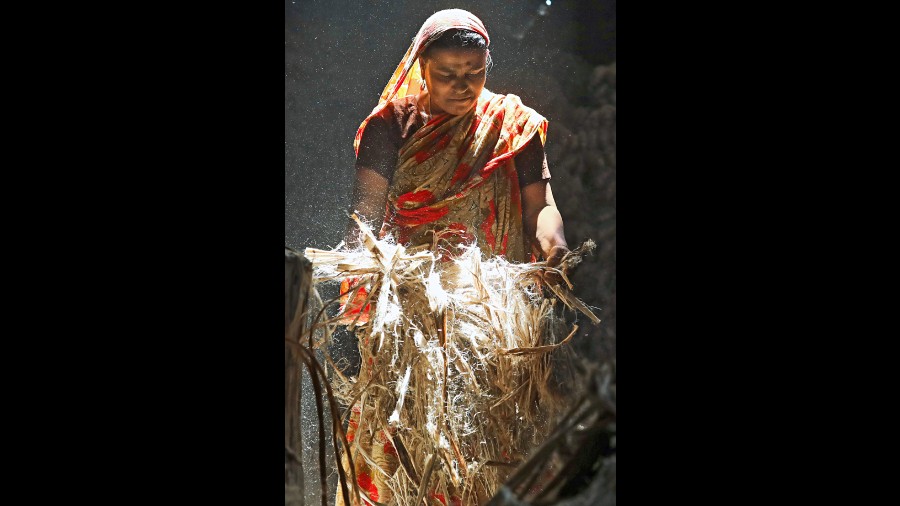When an industry opens its doors to women workers, it can expose how regressive its factory floor is. The face of the jute industry in Bengal has changed over the last 50 years; now more than ever because of the large presence of women.
Once these mills were known as “maagi kol” (meaning factories where women worked; maagi being a colloquialism and not necessarily a pejorative Bengali word for women), because of the substantial number of women employees, especially in the stitching department. Mechanisation drove the women away in the early 1960s. Now they are back, “manning” the new Chinese machines that come with huge output capacities.
“Among the 2,50,000 jute factory workers in Bengal, about 25,000 are women,” says labour activist Naba Dutta, who has worked for jute workers’ rights since the 1980s and is the founder of Nagarik Mancha, a citizens’ forum. It is difficult to arrive at a specific figure because an overwhelming number of workers are temporary employees who do not have their names on the payroll.
The women are returning now, says Dutta, as the men are opting out because of their dissatisfaction with the daily wage — about Rs 400 — a little more than the minimum wage.
The entry of women is good for any management. Generally, they are found to be better workers, more pliant, less prone to unionisation, protests, absenteeism, and to alcoholism.
“Sometimes when I look up, I see only women around me in my shift,” says a young woman worker in a jute mill near Naihati. A shift may employ hundreds of workers. In Bengal now, about 55 jute mills remain functional, after decades of problems and closures. The mills were set up by the British in the 1880s, mostly along the banks of the Hooghly.
But what are the mills doing to the women?
Shampa Ghoshal (name changed), a woman in her 30s, single, with a child and family to support, works in the winding department of a jute mill near Calcutta. She is a graduate, but she could find no other job. Her name went up from the Employment Exchange to a jute mill. In the last three years, she has moved from mill to mill. Currently, she is working in the “B category”, as a temporary employee but with benefits such as provident fund, gratuity and E.S.I. facilities.
Ghoshal operates four winding machines at a time, works eight-hour shifts, including night shifts — something many women complain they are forced into — almost without a break. Everyone is given enormous targets. Sometimes a worker is not allowed even a toilet break, because if the machines stop, the jute may get tangled. This would mean unmet targets, slashed wages.
In a good month, Ghoshal earns Rs 10,000. “But I may drop dead on the factory floor. I have lost 10 kilos in one year,” she says.
“It is a bit like Charlie Chaplin’s Modern Times,” says Debashish Paul, a former employee of the Anglo India Jute & Textile Industries at Kankinara and human rights activist. Paul is still attached to the labour office of the mill. “The targets are inhuman,” stresses Sandip Sinha Roy, a Bhatpara resident like Paul and a labour rights worker.
Naseem Banu (name changed), a middle aged woman who works in a mill in the Naihati area, says her daily target is eight pieces of jute, each 140 metres long, in eight hours. Ghoshal has to produce 450 kilos of jute thread every day.
Recently, a study was conducted by Sanhita, a gender resource centre in Calcutta, in partnership with Nagarik Mancha. Forty-six women in six jute mills around Calcutta were interviewed. Of these, only two were permanent employees. Several jute federation and jute mill union members were also interviewed.
Jute mills suffer from the usual workplace problems for women workers: no maternity leave, earlier retirement age compared to men, no restroom, no changing room. “And this is not the unorganised sector. These women are on the margins of the organised sector,” says Soma Sengupta of Sanhita.
But the most disturbing finding was the prevalence of not only sexual discrimination but also sexual harassment — women being preyed upon by their male supervisors and co-workers.
It works in many ways. Sexual favours are the currency with which women can buy little freedoms, be it unmet targets or a break. (Somehow a man taking a smoke break is less illegitimate.) Women are just expected to give in. Ghoshal says when a supervisor did not get his way with her, he spread rumours that she was available for a few hundred rupees.
Pooja Singh (name changed), a single mother who also has to look after her ageing mother, works at the winding section of a mill near Bhatpara. She works 12 machines at a time and her daily output target is 500 kilos. She fell in love with a colleague. He used his mobile phone to circulate a nude picture, which he claimed was hers. “I felt like killing myself. Log mujhe ganda cheez bolte hai. But I have to go on,” says Singh, tears stinging her eyes.
“Among the women we met, no one had ever heard of the 2013 Act against sexual harassment at workplace or the Vishakha Guidelines,” adds Sengupta.
As Paul points out, women’s problems are often neglected because the general working conditions at jute mills are so appalling. Sengupta wants to address this very problem. To look at sexual harassment as a “women’s issue” is to marginalise it; it is a labour issue, she says.
At a time when World Bank projections put the female labour force participation in India at one of the lowest in the world, the number of women in jute mills is increasing. It shows their desperation.
The situation is doubly ironic given the history of women’s participation in the industry, says Dutta, who is researching the role of women in the jute industry and their disappearance.
In the first decades of the 20th century, migrants from Bihar, Odisha and Andhra Pradesh had settled in Bengal as jute mill workers. In many cases, their wives joined the mills, creating a strong female workforce.
Remarkable women such as Santosh Kumari Devi and Prabhavati Dasgupta came to lead the jute mill trade unions. They may not have foregrounded gender in their work, Dutta says, but their presence alone must have introduced a new dynamic to the industry.
By the late 1940s, women were no longer in leadership positions. Dutta feels that the Left parties jettisoned them because they would not fit into the party straitjackets. By the1960s, women workers, too, disappeared. “The industry was mechanised, but not modernised,” says Dutta.
Till recently, neither mill management, nor the government, not even trade union leaders would acknowledge that women are returning to jute mills. The invisible worker is the best worker; an organisation is the least accountable towards them.
But the women’s growing number cannot keep them invisible anymore. The work place may be changing, too. One of the demands in the charter of demands placed before the Indian Jute Mills Association by several trade unions is for internal committees to be set up within mills to address sexual harassment in the workplace.












